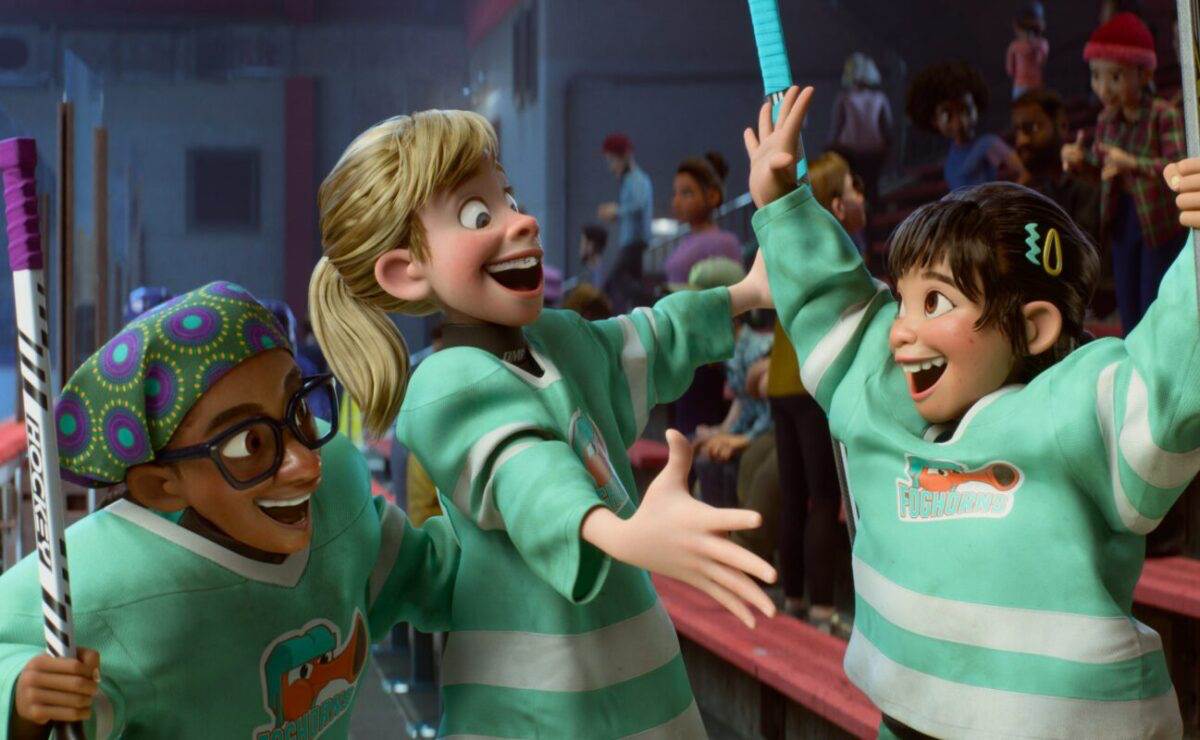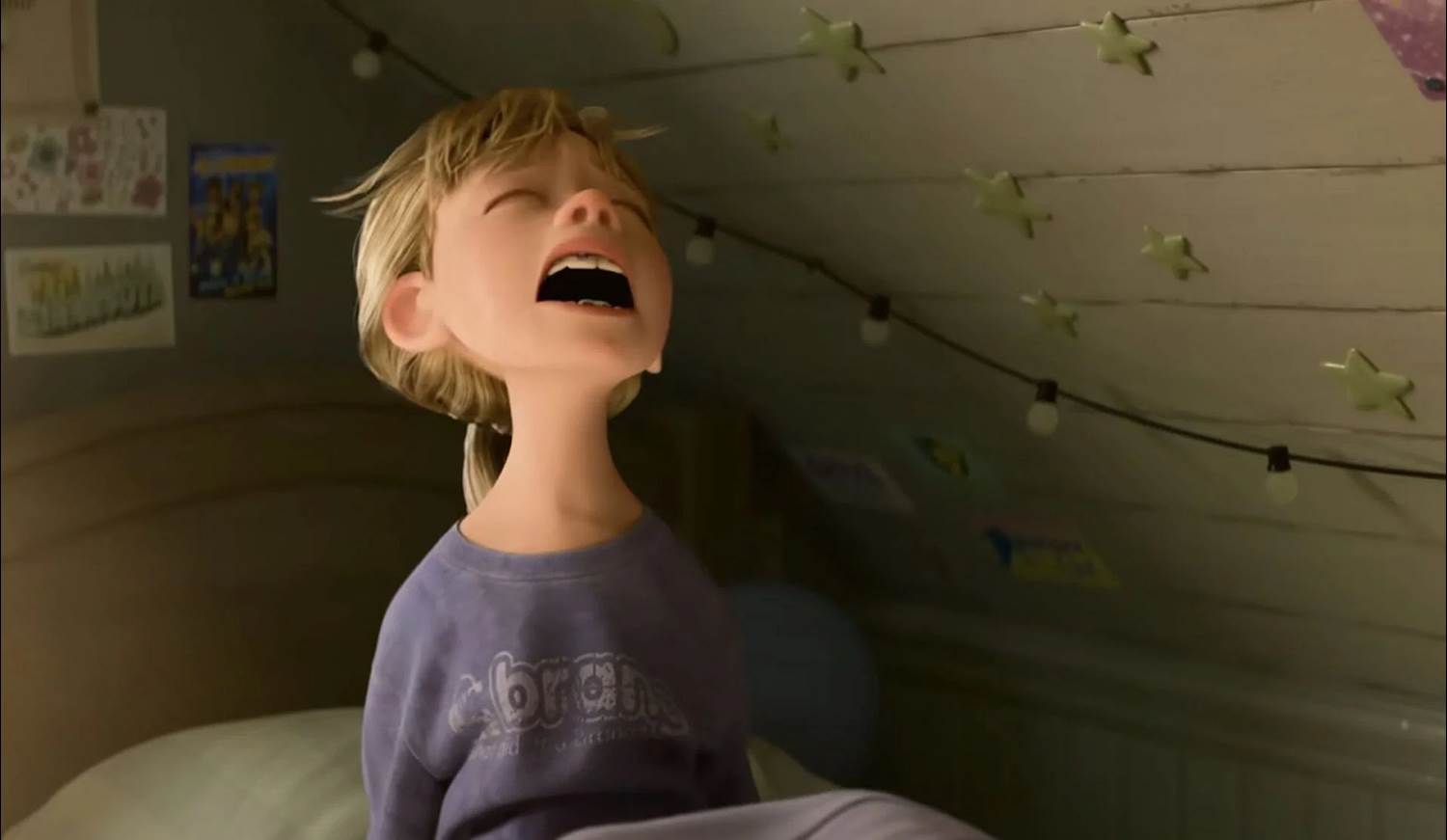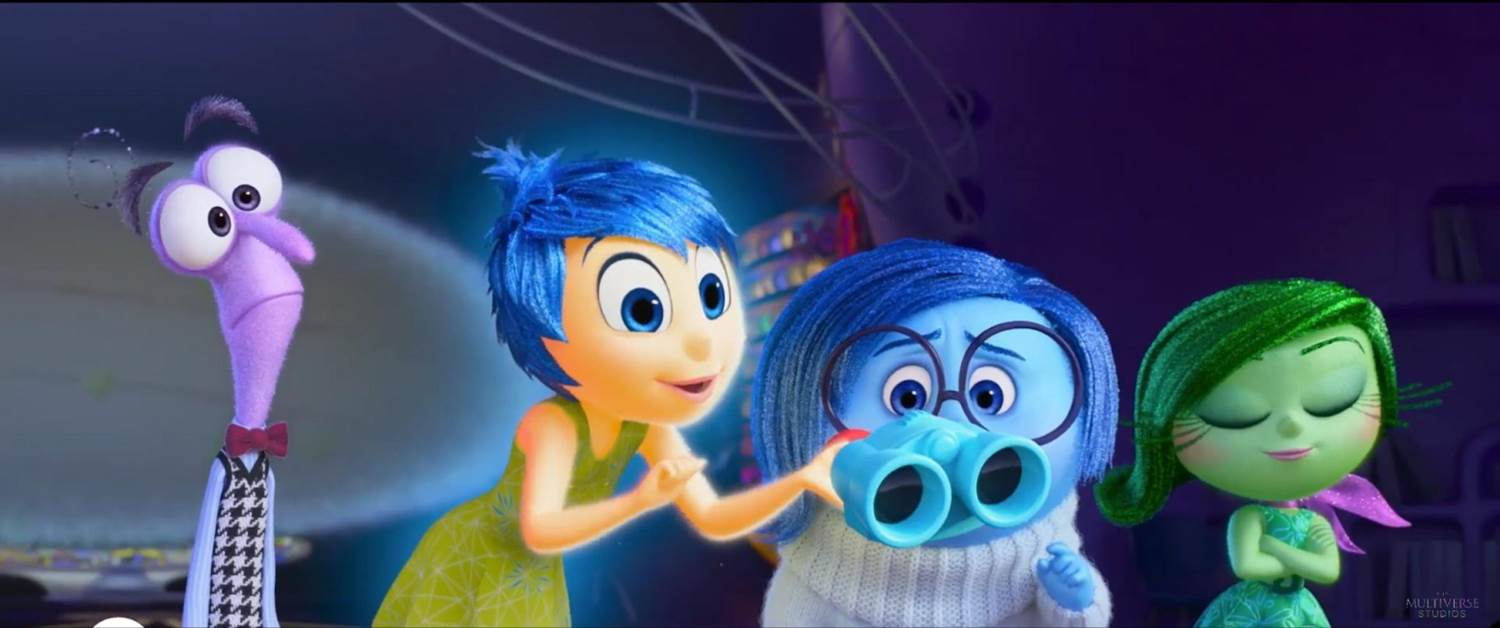Pixar’s Inside Out 2 is now available on digital platforms, Blu-Ray, DVD, Disney+, pretty much everywhere, making it the perfect time to start watching the #1 highest grossing animated film of all-time and scouring it for easter eggs. Alas, we’ve done most of the work for you, but you can go back and find them for yourself with this comprehensive list.
By The Numbers
In the big hockey game we see at the opening of the film, we catch a glimpse of Riley’s jersey number: 28. If you think this is just a random number, you’re wrong. Nothing is ever as random as it might seem in the Pixar universe – and 28 just happens to acknowledge that Inside Out 2 is the 28th full-length animated feature from Pixar Animation Studios. And, in each of those features, fans can also spot another number of sorts – A113.
A113 – celebrating the classroom at CalArts that many animators, including numerous ones important to the history of Pixar Animation Studios studied in, is a number that has been hidden, referenced, or implied in every Pixar film, with some more obvious than others. WALL-E notably makes it an important part of the story while The Good Dinosaur hides it in the log placement on a fence. In the original Inside Out, A113 can be found in graffiti as Riley makes her way through the city streets of San Francisco, but for Inside Out 2, it’s not that simple. Unless you know your Roman Numerals of course. When the emotions are locked away in the vault and breaking free – be sure to keep an eye on the vault numbers. There, in Roman Numerals, you will find A113, but it will read as “ACXIII.”
Joy’s Origami
For many, one of the standout moments of the original Inside Out (and Pixar history for some) was the sacrifice of Riley’s Imaginary Friend, Bing Bong. While many fans of the original wanted him to come back in some way for the sequel, that simply couldn’t happen. While Riley may not remember her imaginary friend anymore, it’s clear that Joy sure does.
As we see the sleeping quarters of the emotions just ahead of the demo day scene, we see the different personally designed areas representing the emotions. If you look at Joy’s, you can see an origami Bing Bong on the shelf next to her bed.
But wait, that’s not the only paper folding fun she’s been up to. We don’t know where she saw it, but somehow she knows what a Pizza Planet truck looks like. As the camera moves slowly toward the emotions as they sleep peacefully (which will soon be interrupted), you can see the Pizza Planet truck in paper form to the left of Joy’s bed area, though your eyes may go toward Bing Bong first, and I personally don’t blame you.
Future Productions
Fans of Pixar Animation Studios know that somewhere in some way a nod to a future production exists in the one that precedes it. In Monsters Inc., Boo plays with a Nemo toy. In Finding Nemo, a patient waiting for the dentist is reading a Mr. Incredible comic book. This goes on through the entire Pixar film catalog, but in most cases, nobody knows what they’re looking at until after the next film is released, so it’s a good payoff for future viewings. However, a lot of fans also pay attention to what the studio announces for the future.
Inside Out 2 finds itself in a very unique situation. Originally planned ahead of the release of Inside Out 2 was Pixar’s Elio. That film has since been delayed to June of 2025, but a reference is still included in Inside Out 2. When Anxiety recalls all the songs Riley knows to be cool in front of Val (the scene in which the Sar-Chasm is opened), one of the memory orbs in headquarters bounces fairly close to camera to the right of the screen, and you can see Elio inside.
Knowing that the animation on Inside Out 2 was completed only several weeks before release (and well after Elio’s delay), this is likely the tribute for the next film in the catalog.
And then, Inside Out 2 has another Easter Egg conundrum. At a certain point, you can see Fear holding a mug with the Dream Productions logo on it. Fans of the first film will recall that this is the studio in Riley’s Imagination that creates all her dreams, including the popular Princess Unicorn series. However, there is also an upcoming series from Pixar based on this studio, set to debut later this year. So is this an homage to the Inside Out past or the Inside Out future? Or is it both? Either way it’s in the film.
Easter Eggs? I Prefer “Reused Assets”
Throughout the movie, and any Pixar movie for that matter, are relics from the studio’s past in plain sight. Often referred to as Easter Eggs (which to an extent is true) more often than not, these are reused assets from studio’s files. Do we need to populate a scene with props? Why model and sculpt something new when we already have a similar object in our files? Fans may immediately think of the antique store in Toy Story 4 or the Hall of Everything in Soul as the go-to destination for easter eggs. This is why.
Take for example a falling piano from the Demo Day sequence. It’s comedic and fun to throw in a falling piano into the scene, but why model and render a brand new one when we can just pull this file – Joe’s Piano from Soul – and put that in the movie. Boom, Easter Egg and saved time! And that’s exactly what happened. That piano, confirmed by Director Kelsey Mann and Producer Mark Nielsen, is in fact, Joe’s Piano from Soul.
Jordan, the boy from the tail end of the original Inside Out and the short, Riley’s First Date, is also brought back in this sequel, and you can see him as one of four heads on Mt. Crushmore later in the film. At another point, when Joy and the emotions are looking upon Riley’s personality islands, they use a pair of binoculars that are the same model (without the legs and pupils) of Lenny in the Toy Story films.
After the new console is installed in headquarters, Riley awakens from her slumber and is wearing her fathers old t-shirt for the company he works for, Brang. It was spotted in the original film and is back in this one, just with a bit more wear and tear and clearly now part of a bedtime outfit.
Interestingly, in this same moment, we can spot a 4-TOWN poster behind Riley. While this is a great treat for fans of the fictitious boy band in Turning Red, it also poses an interesting question. Turning Red is set in the early 2000s, and based on the phones and tech in Inside Out 2, we are set in the present day. So does Riley like retro music? Or is 4-TOWN still relevant 20 years later?
We Love A Parade
While leaving Fort Pillowton, Joy and the emotions find themselves in the middle of Riley’s career parade, which looks an awful lot like a popular Thanksgiving day tradition right out of New York City. It’s an amusing moment but similar to a real parade, you’re looking at those balloons and not much else.
STOP. This is where you need to look around. In one single moment, you’ll not only spot another of Pixar’s traditions and see the famous Pixar Ball, you’ll also a board game called “Journey Into Imagination.”
The name might sound familiar to Pixar fans and it will definitely call out to EPCOT fans everywhere, and that’s exactly what it is. On the board game box, you’ll also see an image of Figment, the impish dragon from the attraction “Journey Into Imagination” at the park. But where can we play this game?! No appearance from original voice Billy Barty, but there is an Inside Out connection to Figment’s current voice – Dave Goelz.
Muppetational Tributes
Dave Goelz, who voices Figment, as well as famous muppets Gonzo and Dr. Bunsen Honeydew among others, also voiced one of the mind workers in the original Inside Out alongside fellow Muppeteer and Disney Legend Frank Oz. The mind workers the voiced? Dave and Frank of course! They were the guards outside of Riley’s subconscious in the first film and return again for the second. Director Kelsey Mann has openly shared his excitement that he got to work with the performers, but they aren’t the only Muppet fun that can be found in Inside Out 2.
Mann has also openly shared his fondness for Big Bird performer Carol Spinney, who has since passed and could not provide a voice for the film. However, a tribute still remains and you can catch it while Riley is hanging out with Val and her team. You’ll notice that while they’re having fun, they’re also enjoying Pizza. While you might think this is the obvious Pizza Planet choice, we’ve already seen that easter egg – and instead they are enjoying pizza from Spinney’s Pizza, a tribute to Carol Spinney.
Back in the 1900s
We love Fort Pillowton for a number of reasons – one of which is the fact that Anxiety has an army of artists, working at what appear to be hand-drawn animation desks that pay homage to the heyday of the artform. Another is that one of these mind workers, according to production designer Jason Deamer, is a likeness of the late Ralph Eggleston, who served as production designer on a number of Pixar films, including the original Inside Out, and was Deamer’s mentor. We haven’t confirmed, but we suspect it’s #87.
And speaking of the 80’s, let’s step back for a moment. There are three main people who were critical to the founding and success of the Pixar Animation Studios – Animator John Lasseter, Computer Scientist Ed Catmull, and Apple Founder Steve Jobs. Jobs was the one who kept the studio afloat when it needed it most, and because of the Apple connection, there have been numerous Apple computer related tributes and send-ups in Pixar’s history. A number can be found in WALL-E, like the iconic Apple start-up sound when Wall-E is fully charged, or in Coco where the offices in the land of the dead are populated with Apple computers that are considered dead technology.
Enter Inside Out 2, which might feature the most subtle Apple homage yet. Also in the Fort Pillowton scene, almost the whole scene is similar to tech company’s iconic 1984 ad. Embedded above and having seen Inside Out 2, you can see the parallels, with really the only main difference being that Anxiety’s screen isn’t being shattered with a sledgehammer, but a revolting mind worker with their chair/stool.
You can find all these easter eggs for yourself (and possibly more) by watching Inside Out 2 now streaming on Disney+, or on digital platforms and physical media.










